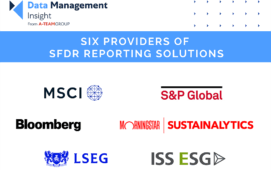
From fossils of the largest beasts to have roamed Earth to microscopic organisms, the ornate halls of London’s Natural History Museum are stuffed with 80 million specimens that chart the past 5 billion years of evolution.
The 142-year-old institution is also a repository and manager of data that may hold the key to predicting how life on earth will change in the coming decades and centuries. Now that data is about to be harnessed by investors to identify how their capital can help preserve and restore the parts of nature lost or damaged by human activities, and whose vulnerability threatens the survival of businesses and entire economies.
The museum’s Biodiversity Intactness Index (BII), a gauge of biodiversity change across the world, will be incorporated into Bloomberg’s own sustainability data offering. The index, which the museum describes as a “health check” for Earth, is fuelled by its Projecting Responses of Ecological Diversity In Changing Terrestrial Systems (PREDICTS) database. This trove of biodiversity information is gleaned from more than 50,000 sites across 100-plus countries covering in excess of 58,000 species of flora, fauna and fungi.It also factors in human pressures on nature to paint a day-by-day picture of the what, where and how of nature’s vulnerabilities.
Crucially for investors, Bloomberg is taking the BII to map across data on almost a million investment assets and show investors which of their holdings are most at risk of a changing world.
“We kept hearing from clients that they need more reliable and accurate data. We explored many datasets and found that the Natural History Museum’s Biodiversity Intactness Index (BII) was best suited to clients’ needs,” Bloomberg’s manager of global regulatory and climate solutions Nadia Humphreys told ESG Insight. “Linking together what a company is doing, where it’s operating and the impact it is having on its local surroundings is critical to help investors interrogate the claims companies are making in their corporate sustainability reports.”
Key Development
ESG Insight identified the growth of biodiversity data provisions as one of the most important developments of 2023. The formulation of the Taskforce for Nature-related Financial Disclosure’s (TNFD) final set of reporting guidelines established nature as almost equal to climate change on the ESG agendas of financial institutions.
The TNFD’s own research illustrates why investors are taking biodiversity loss and preservation so seriously: it estimates that more than half of the global GDP is either moderately or highly dependent on nature. The increasingly destructive forces of severe weather events, such as cyclones and wildfires, caused by climate change combined with the loss of habitats and entire ecosystems is putting businesses at physical and financial risk.
In response, financial institutions have created and invested in funds with a nature and biodiversity focus. According to data from the European Securities and Markets Authority (ESMA), such products in Europe saw assets under management triple in the year to September. It also estimates that bonds that featured biodiversity in their “use of proceeds” declarations increased at a similar clip between 2020 and last year, to 16 per cent of all corporate issuance.
Data Paucity
Like other parts of the ESG market, however, investors are lacking the data and metrics to make comparisons between the relative strengths and weaknesses of their assets.
“Right now, the markets lack reliable data to enable investors pursuing biodiversity strategies to integrate those considerations into investment decisions,” Humphreys said. “There are lots of data sets available, but fragmented between many private and public sector organisations. Most of the data today consist of proximity estimates or measuring extinction levels of a given set of species.”
This has hampered investors in responding, she added.
“The investment community has struggled with how to measure the impact and dependencies that companies they invest in have with nature,” she said.
“The rapid decline of the ecosystems on which we depend is well documented; but the direct causal link between a company, its operations and its impact on nature has been difficult to measure. In the last few years interest in this area has been increasing rapidly due to regulation, voluntary commitments to best practice disclosure and action frameworks.”
Looking Forward
Humphreys said Bloomberg has set about trying to redress that imbalance with an effort to bring datasets together “to build a holistic picture”. The collaboration with the Natural History Museum is a key plank in that policy.
“Key differentiating factors of the BII are that it is science backed, peer reviewed and provided as a credible reference in many reports, including in the TNFD,” Humphreys said. “Once the tool is built, investors can use this critical information to identify companies which are at potentially higher regulatory or reputational risk due to where they are operating and can make engagement or divestment decisions.”
Natural History Museum director Dr Doug Gurr highlighted the importance the forward-looking nature of Bloomberg’s tool.
“Unlike other biodiversity indicators, users can project how biodiversity will change in response to future management decisions,” Gurr said.
Subscribe to our newsletter




